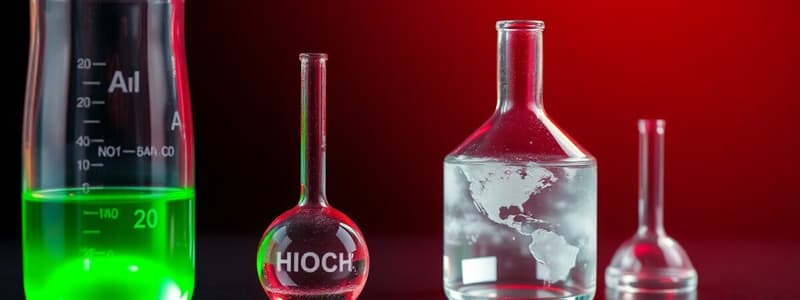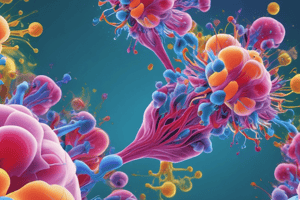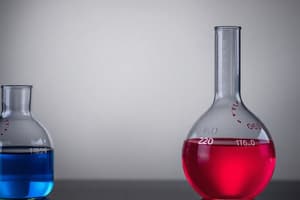Podcast
Questions and Answers
¿Qué se necesita para que una colisión sea efectiva?
¿Qué se necesita para que una colisión sea efectiva?
- Baja energía de activación
- Baja velocidad de reacción
- Energía de activación y orientación adecuada (correct)
- Alta concentración de productos
¿Qué ocurre con la velocidad de reacción al aumentar la concentración de los reactivos?
¿Qué ocurre con la velocidad de reacción al aumentar la concentración de los reactivos?
- Se vuelve impredecible
- Permanece igual
- Disminuye
- Aumenta (correct)
¿Cuál es la definición de complejo activado?
¿Cuál es la definición de complejo activado?
- Estado intermedio de energía máxima (correct)
- Estado intermedio de energía mínima
- Estado inicial de los reactivos
- Estado final de la reacción
¿Cómo influye la superficie de contacto en la velocidad de reacción?
¿Cómo influye la superficie de contacto en la velocidad de reacción?
¿Qué hacen los catalizadores positivos?
¿Qué hacen los catalizadores positivos?
¿Qué efecto tiene un catalizador positivo en la energía de activación?
¿Qué efecto tiene un catalizador positivo en la energía de activación?
En una reacción exotérmica, ¿cómo es la energía de los productos en comparación con los reactivos?
En una reacción exotérmica, ¿cómo es la energía de los productos en comparación con los reactivos?
En una reacción endotérmica, ¿qué ocurre con la energía?
En una reacción endotérmica, ¿qué ocurre con la energía?
En una reacción endotérmica, ¿cómo es la energía de los productos en comparación con la de los reactivos?
En una reacción endotérmica, ¿cómo es la energía de los productos en comparación con la de los reactivos?
¿Cuál de los siguientes factores influye en la velocidad de reacción?
¿Cuál de los siguientes factores influye en la velocidad de reacción?
¿Qué se necesita en las partículas para que una colisión sea efectiva?
¿Qué se necesita en las partículas para que una colisión sea efectiva?
¿Cómo afecta el movimiento de las partículas a las colisiones?
¿Cómo afecta el movimiento de las partículas a las colisiones?
En reacciones, ¿qué liberan las reacciones exotérmicas?
En reacciones, ¿qué liberan las reacciones exotérmicas?
¿Cuando hay mayor superficie de contacto, cómo se demorará la colisión efectiva?
¿Cuando hay mayor superficie de contacto, cómo se demorará la colisión efectiva?
¿Qué tipo de sustancias influyen en la velocidad de reacción?
¿Qué tipo de sustancias influyen en la velocidad de reacción?
En una reacción, ¿qué absorben las reacciones endotérmicas?
En una reacción, ¿qué absorben las reacciones endotérmicas?
No todas las colisiones son ... esto quiere decir que no todos los choques dan lugar a reacciones químicas.
No todas las colisiones son ... esto quiere decir que no todos los choques dan lugar a reacciones químicas.
En una reacción exotérmica, ¿qué tienen menos energía que los reactivos?
En una reacción exotérmica, ¿qué tienen menos energía que los reactivos?
Flashcards
Effective Collision
Effective Collision
Collision of particles is necessary, but not all collisions result in chemical reactions; they must be effective.
Activation Energy
Activation Energy
Minimum energy needed for a collision to result in a reaction.
Activated Complex
Activated Complex
Intermediate state, maximum energy, particles in correct order orientation.
Reaction Rate
Reaction Rate
Signup and view all the flashcards
Catalysts
Catalysts
Signup and view all the flashcards
Positive Catalysts
Positive Catalysts
Signup and view all the flashcards
Negative Catalysts
Negative Catalysts
Signup and view all the flashcards
Exothermic Reactions
Exothermic Reactions
Signup and view all the flashcards
Endothermic Reactions
Endothermic Reactions
Signup and view all the flashcards
Study Notes
- Collisions must occur for a reaction to take place.
- Not all collisions are effective in yielding chemical reactions.
- Effective collisions require activation energy (minimum necessary energy) and proper orientation.
- Activated complex: intermediate state of maximum energy.
Reaction Velocity
- Reaction velocity represents how quickly products form.
- Concentration of reactants: higher concentrations increase collision probability in less time.
- Contact surface: more surface area allows more effective collisions in less time.
- Increased particle movement leads to more collisions.
- Catalysts: substances that affect reaction velocity without being consumed.
Catalysts
- Positive catalysts: increase reaction rate and decrease activation energy.
- Negative catalysts: decrease reaction rate and increase activation energy.
Reactions
- Exothermic reactions: release energy, products have less energy than reactants, H(product) - H(reactant) = -H.
- Endothermic reactions: absorb energy, products have more energy than reactants, H(product) - H(reactant) = H.
Studying That Suits You
Use AI to generate personalized quizzes and flashcards to suit your learning preferences.




